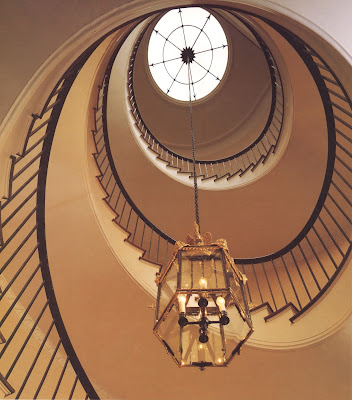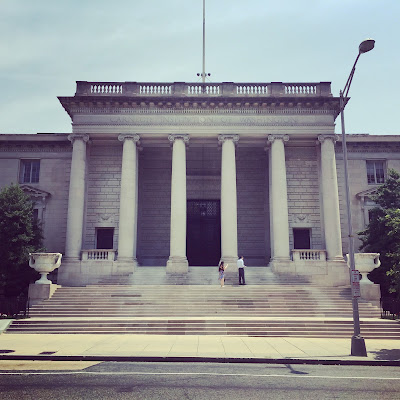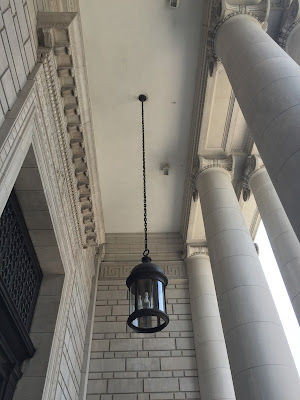Today I bring you Oheka Castle through a music video by Taylor Swift. Oheka Castle on Long Island was designed by Delano and Aldrich in 1914 for Otto Kahn. The structure happens to be the 2nd largest private house in the United States after the Biltmore estate. The house is gorgeous and the song is really fun; I'll admit to being a big Taylor Swift fan! If you're not into the music I still encourage you to watch the video on mute for the images of Oheka Castle alone. Enjoy!
Showing posts with label Delano and Aldrich. Show all posts
Showing posts with label Delano and Aldrich. Show all posts
Saturday, October 8, 2016
Tuesday, October 4, 2016
While cleaning through my over-flowing bookcases the other day I came across an old favorite, Adventures with Old Houses by Richard Hampton Jenrette. The book is an account of the 14 historic houses he has bought, restored, and called home. One (or 2 rather) in particular have always been my favorites, the George F Baker house by Delano & Aldrich (more on them HERE and HERE).
The Ionic columns front a terrace on the main level of the townhouse in the courtyard created by the compound of buildings.
The yellow continues down the central corridor. Notice how Delano and Aldrich broke up the long hallway by creating different spaces with archways -a great architectural trick.
At the end of this long hall is the oval dining room with original marble flooring. Jenrette choose the chocolate brown walls to match the floor and they help bring out the decorative trimwork to best advantage.
Looking back towards the hall, through tall polished mahogany doors, one catches a glimpse of the beautiful curved stair.
Stairs such as these are always the focal point of such elegant houses. Notice the greek key trim bordering the stair runner.
The library uses the rounded bay but is rather larger than the dining room below as it is a rectangular and not an oval room.
The carriage house behind, which was converted into a residence years ago, features this beautiful Adam-style fireplace from 1800 by master woodworker Robert Wellford.
A small sitting room, which was combined with a small bedroom to create a beautiful guest room, features lovely neoclassical painted paneling. I love the marble surround and quiet wood mantel which integrates into the paneling. Classical houses such as this always make my heart sing, how about yours?
Read more about the house and the full compound of buildings at Daytonian in Manhattan.
All images from the book Adventures with Old Houses by Richard Hampton Jenrette featuring photographs by John M Hall and not my own.
Finished in 1914 for Francis F. Palmer by Delano and Aldrich, the house was later added onto to form a complex. The house was bought in 1917 by George F Baker and Jenrette named the house after him. It still is Jenrette's home base in NYC with the carriage house (where he formerly lived) as offices for his historic foundation, the Classical American Homes Preservation Trust.
Above is the entry to the carriage house from the street. I love this combination of deep forest green with granite detailing and red brick. Mr Jenrette originally bought the house located at 67 East 93rd Street in NYC, restored and sold it, moved into the carriage house behind at 69 East 93rd Street, and later bought BACK the townhouse for less than he had sold it, and moved back in! Get all that? He has retained the carriage house for the offices of his foundation.The Ionic columns front a terrace on the main level of the townhouse in the courtyard created by the compound of buildings.
Floorplans show the very organized layout to the townhouse.
Sunny yellow and a roaring fire greet guests in the entry hall. Mr. Jenrette has always bought period furnishings for his many homes.The yellow continues down the central corridor. Notice how Delano and Aldrich broke up the long hallway by creating different spaces with archways -a great architectural trick.
At the end of this long hall is the oval dining room with original marble flooring. Jenrette choose the chocolate brown walls to match the floor and they help bring out the decorative trimwork to best advantage.
Looking back towards the hall, through tall polished mahogany doors, one catches a glimpse of the beautiful curved stair.
Stairs such as these are always the focal point of such elegant houses. Notice the greek key trim bordering the stair runner.
The library uses the rounded bay but is rather larger than the dining room below as it is a rectangular and not an oval room.
The carriage house behind, which was converted into a residence years ago, features this beautiful Adam-style fireplace from 1800 by master woodworker Robert Wellford.
A small sitting room, which was combined with a small bedroom to create a beautiful guest room, features lovely neoclassical painted paneling. I love the marble surround and quiet wood mantel which integrates into the paneling. Classical houses such as this always make my heart sing, how about yours?
Read more about the house and the full compound of buildings at Daytonian in Manhattan.
All images from the book Adventures with Old Houses by Richard Hampton Jenrette featuring photographs by John M Hall and not my own.
Label:
architecture,
books,
Delano and Aldrich,
furniture,
interiors
Monday, October 3, 2016
Last week I had the pleasure of touring the Carnegie Institute of Science with our local branch of the ICAA (these lunch time tours we offer are my favorite aspect of the ICAA). I have been walking past this building on 16th street NW for as long as I've lived in Washington but never knew the glories that were inside!
The old front door facing 16th street is seldom used (it is solid bronze and weighs literal TONS) which is a shame because the detailing on the front porch is phenomenal.
The block to the left of the new entrance very closely matches the original structure but with a stripped-down style of classicism so popular in the 1930s (which I find to be my favorite classical 'flavor').
The 'new' entry opens into a sedate 2 story stairhall which closely matches the pared-down classicism of the exterior. Notice the nod to Andrew Carnegie's Scottish heritage with the thistle motif incorporated into the balustrade (more on this later).
1938 was nearing the end of grand public classicism and hints of what were to come are to be found throughout the structure; the custom light fixture below was designed in a 'scientific' Art Deco style for the space by Delano & Aldrich. Notice the barrel vaulted ceiling with Greek key plaster trim.
At the top of the staircase is Carrere and Hasting's meeting room -which was a multi purpose room used as both large meeting room and auditorium.
The classical detailing here is superb. Notice the excellent care which the institute takes of the building - they are to be commended for it! Everything is original; maintained and kept in admirable working order.
The herringbone floors add a layer of scale to the enormous space.
The only modern touches are the occasional (dreaded) recessed lights. Other than occasional use in kitchens and bathrooms I would be very happy to BAN recessed lighting from all buildings - ceiling acne.
Symmetry and classical detailing make sense of the space and add human scale. This is something modern architecture has a hard time dealing with.
The enfilade effect created by symmetry make the building seem much larger than it actually is by setting up views. People may poo-poo lining everything up in plan but I've never met anyone who wasn't impressed with this architectural trick when viewing it in person; it just feels good.
The original entry foyer is a grand domed space; so sad it isn't still used as the entry! It is however available to rent and is frequently used for weddings and other private events. On these occasions they'll open up the original front doors as Carrere and Hastings intended (money talks).
The graceful stair to the 2nd floor is off the entry hall.
Who doesn't love a curved staircase like this?
The columns aren't marble but rather scagliola, a faux-finish which mimics the stone. The Carnegie just restored the scagliola finish to 8 of the columns last year and plan on doing the remaining 8 this next year -all part of the maintenance of an old building (or house!).
The use of natural light is found throughout the building with skylights as well as the large French doors found on the exterior.
Above are the original bronze front doors.
One's eyes are instantly drawn up into the dome though - topped with a chandelier centered on a skylight.
Probably my favorite part of the entire building though is the economical use of linoleum on the 2nd floor instead of the marble found on the main level. I think linoleum is going to be making a comeback and you can see why!
The wood paneled library on the 2nd floor is also lit by a large skylight making for a pleasant environment.
These HVAC vents in the library also feature the Scottish thistle. I wonder if they date to Carrere & Hastings and Delano & Aldrich picked up on this motif for their new staircase or if this custom vent was lated added by D&A.
On the main level this impressive wood paneled room with enormous marble mantel was originally the office of the president. It is used as rental space and for meetings today.
These enormous old brass andirons in the fireplace caught my eye.
As did the beautiful brass cremone bolts on the french doors.
An easy and inexpensive trick found in some of the other lesser rooms help with the proportions of the tall ceilings is seen above. Rather than a standard base of 5 to 8" tall a chairrail was added about 18" off the ground, everything below it painted the same color as the base. This raises the visual height of the base without a lot of expensive woodwork (which would sloppily jut beyond the door casing). I'm definitely filing this away for future use!
The main aspect of the Delano & Aldrich 1938 addition was a formal auditorium for lectures. This beautiful wood-paneled, art-deco vestibule seen above leads to the auditorium. Notice the barrel vaulted ceiling and bowed (rounded) ends - much like a ship. I also loved the very art deco linear light fixture.
The auditorium space is lined with an expansive mural which was recently restored.
This room has a lot of personality between the beautiful murals and the purple mohair upholstered seats!
The mural is painted on perforated homosote board to help with the acoustics.
The most unusual feature of the auditorium is the light fixture: recessed lights in the barrel-vaulted ceiling are covered with photocells featuring the phases of the moon! Ok -so maybe not ALL recessed lighting is so bad.
This bust of Andrew Carnegie is prominently displayed in the entry hall. He may have amassed his wealth in a less than friendly fashion (as is most wealth accumulated to this day) but he spectacularly donated it to the public through institutions such as this and the libraries we all know and love to this day.
I hope if you're in the area you'll join us at the ICAA on our future tours!
The old front door facing 16th street is seldom used (it is solid bronze and weighs literal TONS) which is a shame because the detailing on the front porch is phenomenal.
The original building (located on 16th street) was completed in 1908 by architects Carrere and Hastings for Andrew Carnegie (click the link for more projects by Carrere and Hastings featured on this blog). You can see the front facade in the first photograph of this post and the side elevation (on P street NW) below.
As the institution grew the need for more space was accommodated by a large addition by the architects Delano and Aldrich in 1938 (click the link for more projects by Delano and Aldrich featured on this blog). Part of this addition is the carriage drive and new entrance which is a streamlined version of the Carrere and Hasting's Classicism.The block to the left of the new entrance very closely matches the original structure but with a stripped-down style of classicism so popular in the 1930s (which I find to be my favorite classical 'flavor').
The 'new' entry opens into a sedate 2 story stairhall which closely matches the pared-down classicism of the exterior. Notice the nod to Andrew Carnegie's Scottish heritage with the thistle motif incorporated into the balustrade (more on this later).
1938 was nearing the end of grand public classicism and hints of what were to come are to be found throughout the structure; the custom light fixture below was designed in a 'scientific' Art Deco style for the space by Delano & Aldrich. Notice the barrel vaulted ceiling with Greek key plaster trim.
At the top of the staircase is Carrere and Hasting's meeting room -which was a multi purpose room used as both large meeting room and auditorium.
The classical detailing here is superb. Notice the excellent care which the institute takes of the building - they are to be commended for it! Everything is original; maintained and kept in admirable working order.
The herringbone floors add a layer of scale to the enormous space.
The only modern touches are the occasional (dreaded) recessed lights. Other than occasional use in kitchens and bathrooms I would be very happy to BAN recessed lighting from all buildings - ceiling acne.
Symmetry and classical detailing make sense of the space and add human scale. This is something modern architecture has a hard time dealing with.
The enfilade effect created by symmetry make the building seem much larger than it actually is by setting up views. People may poo-poo lining everything up in plan but I've never met anyone who wasn't impressed with this architectural trick when viewing it in person; it just feels good.
The original entry foyer is a grand domed space; so sad it isn't still used as the entry! It is however available to rent and is frequently used for weddings and other private events. On these occasions they'll open up the original front doors as Carrere and Hastings intended (money talks).
The graceful stair to the 2nd floor is off the entry hall.
Who doesn't love a curved staircase like this?
The columns aren't marble but rather scagliola, a faux-finish which mimics the stone. The Carnegie just restored the scagliola finish to 8 of the columns last year and plan on doing the remaining 8 this next year -all part of the maintenance of an old building (or house!).
The use of natural light is found throughout the building with skylights as well as the large French doors found on the exterior.
Above are the original bronze front doors.
One's eyes are instantly drawn up into the dome though - topped with a chandelier centered on a skylight.
Probably my favorite part of the entire building though is the economical use of linoleum on the 2nd floor instead of the marble found on the main level. I think linoleum is going to be making a comeback and you can see why!
The wood paneled library on the 2nd floor is also lit by a large skylight making for a pleasant environment.
These HVAC vents in the library also feature the Scottish thistle. I wonder if they date to Carrere & Hastings and Delano & Aldrich picked up on this motif for their new staircase or if this custom vent was lated added by D&A.
On the main level this impressive wood paneled room with enormous marble mantel was originally the office of the president. It is used as rental space and for meetings today.
These enormous old brass andirons in the fireplace caught my eye.
As did the beautiful brass cremone bolts on the french doors.
An easy and inexpensive trick found in some of the other lesser rooms help with the proportions of the tall ceilings is seen above. Rather than a standard base of 5 to 8" tall a chairrail was added about 18" off the ground, everything below it painted the same color as the base. This raises the visual height of the base without a lot of expensive woodwork (which would sloppily jut beyond the door casing). I'm definitely filing this away for future use!
The main aspect of the Delano & Aldrich 1938 addition was a formal auditorium for lectures. This beautiful wood-paneled, art-deco vestibule seen above leads to the auditorium. Notice the barrel vaulted ceiling and bowed (rounded) ends - much like a ship. I also loved the very art deco linear light fixture.
The auditorium space is lined with an expansive mural which was recently restored.
This room has a lot of personality between the beautiful murals and the purple mohair upholstered seats!
The mural is painted on perforated homosote board to help with the acoustics.
The most unusual feature of the auditorium is the light fixture: recessed lights in the barrel-vaulted ceiling are covered with photocells featuring the phases of the moon! Ok -so maybe not ALL recessed lighting is so bad.
This bust of Andrew Carnegie is prominently displayed in the entry hall. He may have amassed his wealth in a less than friendly fashion (as is most wealth accumulated to this day) but he spectacularly donated it to the public through institutions such as this and the libraries we all know and love to this day.
I hope if you're in the area you'll join us at the ICAA on our future tours!


































































